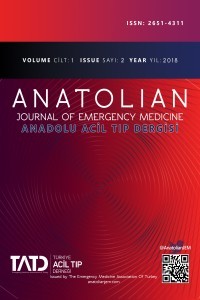
Anatolian Journal of Emergency Medicine
Yazarlar: İbrahim TOKER, Nilüfer KAHRAMAN, Tanzer KORKMAZ
Konular:Tıp
Anahtar Kelimeler:Pulmonary embolism,Abdominal pain,Emergency medicine
Özet: To the Editor, Pulmonary embolism (PE) is a life-threatening condition with many different clinic manifestations, including, although rarely, abdominal pain. Potential mechanisms behind this abdominal pain include diaphragmatic pleurisy originating from a pulmonary infarction at the base of the lungs, and secondary passive hepatic congestion with acute right ventricular dysfunction (1). A 24-year-old woman admitted to our emergency department (ED) due to right upper abdominal pain that had started two days earlier and had worsened on the day of admission. Abdominal pain was increased in the supine position and with deep inspiration. Before presentation at the ED, she examined by a general surgeon and an infectious disease doctor; an abdominal ultrasonographic examination had been performed but showed no abnormalities. The patient was diagnosed with a urinary tract infection, and treatment had started. There was no prior history of significant diseases. She has been using oral contraceptives for the last one year. The patient's vital signs on admission were a temperature of 36.6°C, blood pressure of 160/100 mmHg, heart rate of 130 beats per minute, and respiratory rate of 24 breaths per minute, and her oxygen saturation was 98% while breathing room air. On abdominal examination, she had right upper quadrant tenderness and voluntary guarding without rebound tenderness on palpation. She was tachycardic, but heart sounds were normal with no rubs, murmurs, or gallops. Lung sounds were bilaterally equal and normal with no rales, rhonchi, or wheezes. In the blood gas analysis administered while the patient was breathing room air, pH was 7.46, pCO2 was 29.3 mmHg, pO2 was 106 mmHg, HCO3 was 22.6 mmol/L, base excess was -3.2, lactate was 1.3 mmol/L and oxyhemoglobin rate was 98.3%. Laboratory findings on admission were white blood cell count 16,4x103, hemoglobin 12,7 g/dL, C-reactive protein level 15.6 mg/dL. The serum electrolytes, glucose, blood urea nitrogen, and creatinine were normal. The patient's Wells's score was 1,5 points and had a low pretest probability. The D-dimer level determined was 640 ng/mL. A chest x-ray (CXR) at the ED showed a wedge-shaped opacity in the right lower lobe (Figure 1), and a subsequent chest computer tomography (CT) angiography was performed and revealed an acute PE (Figure 2). The patient was admitted to the chest disease service for observation. After one week of anticoagulation therapy, she was discharged without any problems. PE has a wide range of clinical features, from no symptoms to shock or sudden death. The most common presenting symptom is shortness of breath and chest pain and cough. However, many patients have mild or nonspecific symptoms or are asymptomatic. A meta-analysis of clinical signs alone found a sensitivity of 85 percent and specificity of 51 percent, respectively, for the diagnosis of PE. Abdominal pain is a rare complaint about PE, and previous studies show an incidence of 6.7%(2). Therefore, maintaining a high level of suspicion is critical so that clinically relevant cases are not overlooked. CXR is neither a sensitive nor a specific tool to diagnose PE, but it can be used for the differential diagnosis of chest pain and abdominal pain. Indications of PE, including Hampton's hump, the Westermark, and Palla's signs, pleural effusion, and elevated diaphragm, can all be observed by CXR (3,4). The Hampton's hump, a wedge-shaped opacity with the base along the pleural surface, may be particularly useful to emergency physicians in indicating a pulmonary infarction resulting from PE (4). Here, we describe an interesting PE case that can easily overlook. Emergency physicians should maintain a systematic approach and be aware of the various signs, symptoms, and radiographic signs. A PE can masquerade as a variety of other diseases.